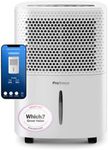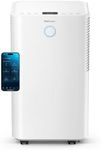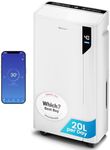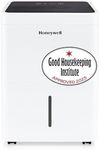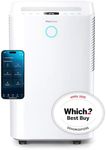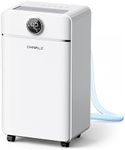Buying Guide for the Best Home Dehumidifiers
Choosing the right home dehumidifier can significantly improve the air quality in your living space, making it more comfortable and healthier. When selecting a dehumidifier, it's important to consider various factors such as the size of the area you need to dehumidify, the humidity levels, and specific features that can enhance the device's performance and convenience. Understanding the key specifications will help you make an informed decision that best suits your needs.CapacityCapacity refers to the amount of moisture a dehumidifier can remove from the air within a 24-hour period, usually measured in pints or liters. This spec is crucial because it determines how effective the dehumidifier will be in your space. For small rooms or areas with mild humidity, a lower capacity (20-30 pints) may suffice. Medium-sized rooms or areas with moderate humidity might require a capacity of 30-50 pints. Large spaces or areas with high humidity levels will benefit from a higher capacity (50+ pints). To pick the right capacity, consider the size of the room and the severity of the humidity problem.
Coverage AreaCoverage area indicates the maximum square footage a dehumidifier can effectively handle. This spec is important because it ensures the device can manage the humidity levels in your entire space. Small dehumidifiers typically cover up to 300 square feet, medium ones can handle 300-700 square feet, and large units can cover areas over 700 square feet. To choose the right coverage area, measure the size of the room or area you need to dehumidify and select a model that matches or exceeds this measurement.
Energy EfficiencyEnergy efficiency is measured by the Energy Star rating or the amount of energy the dehumidifier uses to operate. This spec is important for reducing electricity costs and minimizing environmental impact. Energy-efficient models consume less power while providing effective dehumidification. Look for dehumidifiers with an Energy Star rating or those that specify low energy consumption. If you plan to use the dehumidifier frequently or for extended periods, an energy-efficient model will be more cost-effective in the long run.
Noise LevelNoise level refers to the amount of sound the dehumidifier produces while operating, usually measured in decibels (dB). This spec is important for ensuring a quiet and comfortable environment, especially if the dehumidifier will be used in bedrooms or living areas. Lower noise levels (below 50 dB) are ideal for quiet spaces, while higher noise levels (above 50 dB) may be acceptable in less sensitive areas like basements or garages. Consider where you will place the dehumidifier and choose a model with a noise level that won't disrupt your daily activities.
Drainage OptionsDrainage options refer to how the dehumidifier disposes of the collected water. This spec is important for convenience and maintenance. There are typically two options: manual drainage, where you empty the water tank yourself, and continuous drainage, which uses a hose to automatically drain water into a sink or drain. Manual drainage is suitable for occasional use or smaller tanks, while continuous drainage is ideal for larger tanks or frequent use. Consider your preference for maintenance and the availability of a nearby drain when choosing the drainage option.
Additional FeaturesAdditional features can enhance the functionality and convenience of a dehumidifier. Common features include adjustable humidistat, auto-restart, timer, and air filters. An adjustable humidistat allows you to set the desired humidity level, ensuring optimal comfort. Auto-restart is useful in case of power outages, as it resumes operation with previous settings. A timer lets you schedule operation times, and air filters can improve air quality by trapping dust and allergens. Consider which features are important to you based on your specific needs and preferences.





